Whole grains are well-known for being important and valuable to overall health, but when it comes to weight loss, people tend to get confused about whether whole grains have their place in a healthy diet or not.
The truth is that whole grains are one of the top foods most consistently linked to weight loss and better health for years overtime.
In other words, they help you lose weight for the long run when they are included in a healthy diet in whole grain form.
Unlike quick fix diets, diets rich in whole grains have been shown to promote longevity, better heart health, and can help you maintain consistent weight loss.
First, what are whole grains?
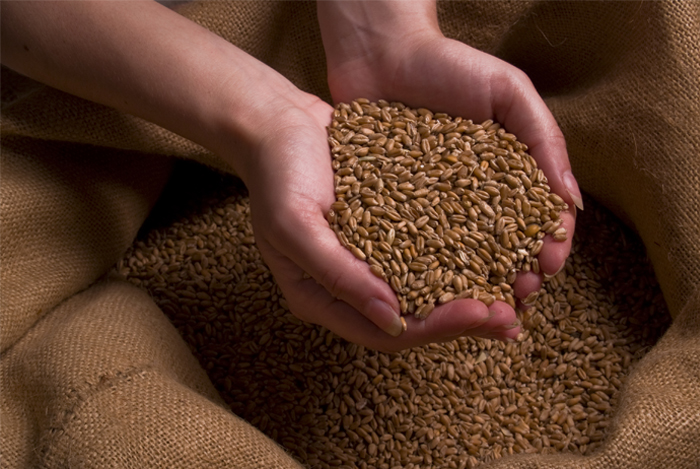
The term whole grain means the grain has not been stripped of one of its three parts and it remains in tact the way nature intended it to be.
A grain is made up of an endosperm, germ, and bran. Each of these parts of the plant plays a special role in its survival mechanisms in nature along with its nutritional benefits.
The Three Parts That Make up a Whole Grain:
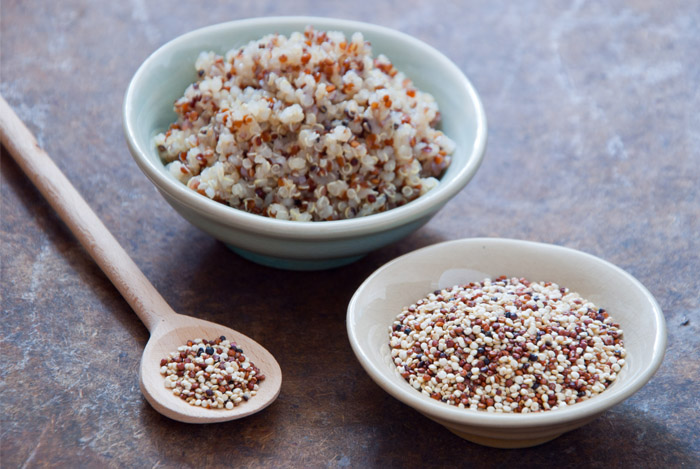
1. The Endosperm
The endosperm is typically the starchiest part of the grain and is what the plant feeds off during its growing season.
Starches turn into sugars which are used and stored as long-lasting energy for the body (or in nature, the plant) to help us grow and thrive. Without this part of the grain, the filling factor and energizing benefits that whole grains have to offer would be lacking.
2. The Bran
The bran is the most fibrous part of the grain since it’s high in cellulose, an indigestible type of plant fiber. Bran takes work for the body to digest and in turn, improves metabolism by cranking up the speed at which the body has to work to digest and use it for nutrients.
You can easily see now why oat bran is so popular for weight loss diets! Bran is also beneficial for the heart since it helps eliminate cholesterol from the blood stream and aids in overall good digestive health. The fibers found in bran also help to feed good bacteria in the digestive system to help improve the health of our microbiome.
3. The Germ:
Now, let’s talk about the germ. The germ is the fattiest part of the grain. It is often where the Vitamin E and healthy fats that some grains contain are included. Think of wheat germ, for example, which is high in Vitamin E, a fat-soluble vitamin we need for good health.
Oats are one of the grains highest in fat and this is because their germ is incredibly nutrient dense with healthy fats. Oats even provide small amounts of omega-3 fatty acids and monounsaturated fats, two types of fats that are incredibly important for our weight, brain function, and heart health.
You can see how each of these parts of a grain make it a complete package of nutrition. A whole grain is simply filled with benefits for the body and even though whole grains are high in carbs, each part of a whole grain has something to offer in terms of weight loss and overall health benefits.
Now, let’s talk about how to choose the best whole grains for weight loss and which ones you’ll want to avoid if you’re trying to lose the most weight possible.
Top 5 Grains That Are Best for Weight Loss:
1. Oats

Let’s start with one of the most popular grains that you’re likely already eating. Oats are high in some of the most important nutrients for weight loss including beta glucan fibers, B vitamins, magnesium, protein, iron, potassium, and even calcium.
Each of these nutrients works to improve metabolic function in the body, lower blood pressure levels, improve heart function, and they can help boost serotonin in the brain to improve mood and reduce cravings for sugary foods.
Oats are also energizing, so you’re much more likely to feel as though you can take on a day full of activities when you enjoy oatmeal for breakfast.
Oatmeal also makes for a great alternative grain at dinner if you’re trying to avoid less healthy grains like white rice, lasagna, and pasta. Oats can be served up savory style just like any other grain and offer a terrific filling factor!
Tips for choosing oatmeal at the store:
Always go with plain oats, not flavored or instant varieties of oats. Steel-cut, rolled, and quick oats are the best forms to choose and they are similar in nutrition, although steel cut oats will keep you full longer than rolled or quick oats. Whole oat groats can also be purchased. These are the most nutrient-dense form of oatmeal but they do take much longer to cook.
Avoid products made with oats like bread or breakfast bars. Even though they contain oats, they are not as filling, have added ingredients, and do not offer the same health and weight loss benefits that whole oats do.
Tips for preparing oatmeal:
Cook your oats with water or unsweetened non-dairy milk in place of milk or sugary non-dairy beverages. Flavor your oats with fruit, cinnamon, or some liquid stevia in place of sugary sweeteners. Complement your bowl of oats with some healthy nuts and seeds such as flax, chia, pumpkin or sunflower seeds, or almonds, walnuts, cashews, and pecans. Keep nuts and seeds to 2 tablespoon servings to avoid overloading on fat in one meal.
What about oat bran?
Oat bran is also a good option if you want to include it in your diet. Oat bran, however, is not a whole grain but it retains many of the same benefits that whole oats have to offer.
Because it is high in fiber, protein, and overall very nutrient-dense, I suggest using ½ oat bran and ½ whole oats for the most benefits if you’d like to include oat bran in your routine.
2. Kamut
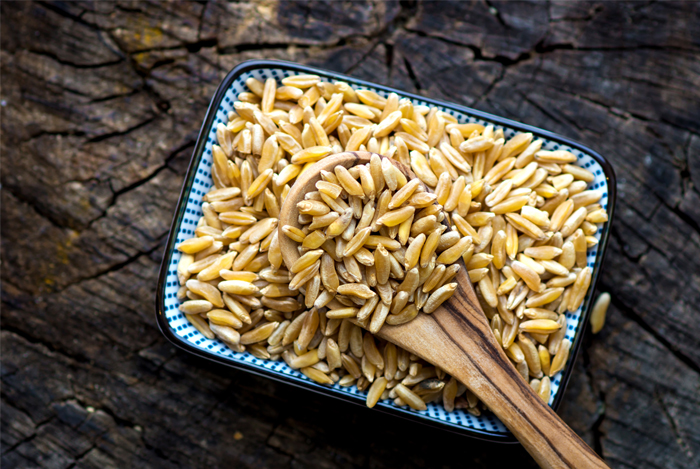
Kamut is a relative of wheat and is an ancient form native to Egypt that is very different from the type of wheat that we know of today and that many of us avoid. Traditional wheat grown here in the United States is high in gluten and fructans (types of sugars found in plants) which make it very hard to digest for many people.
Kamut, however, is an ancient form of wheat that is very easy to digest and more beneficial than traditional wheat because it reduces blood sugar levels, improves satiety, and can improve metabolic function.
Kamut is high in protein, iron, magnesium, manganese, zinc, Vitamin E, and it’s a great source of B vitamins such as folate and Vitamin B6.
It can contribute to a healthier mood, and higher energy levels. Kamut is also a good source of fiber and low in fat just like regular wheat.
While Kamut does contain gluten, the amount is very low and not problematic for most people who don’t have celiac disease.
Kamut grain tastes much like oatmeal with a bit of a heartier and nuttier flavor than oats that is similar to wheat. It’s a great alternative or addition to oats if you’d like to choose a different grain to enjoy or you can mix them together.
Tips for choosing Kamut at the store:
Kamut can be found in its traditional whole grain form, the Kamut kernel, or it can be bought in rolled form just like oats can. Kamut flakes and plain, puffed Kamut cereal are also available which are whole grain forms of Kamut. Just be sure when you purchase Kamut that the only ingredient is whole grain Kamut and you’ll be good to go!
Tips for preparing Kamut:
When preparing Kamut for breakfast like oatmeal, keep the rules the same: always avoid added sugars and chose spices such as cinnamon or fruit to flavor your Kamut. Cooking with water or unsweetened non-dairy milk is also best.
As a savory option, Kamut can be prepared in some low-sodium broth to add flavor, cooked by itself or with some vegetables, and can be seasoned with any spices you enjoy such as turmeric, oregano, or basil and black pepper. Try out a few ways to use Kamut and see how you like it!
3. Barley
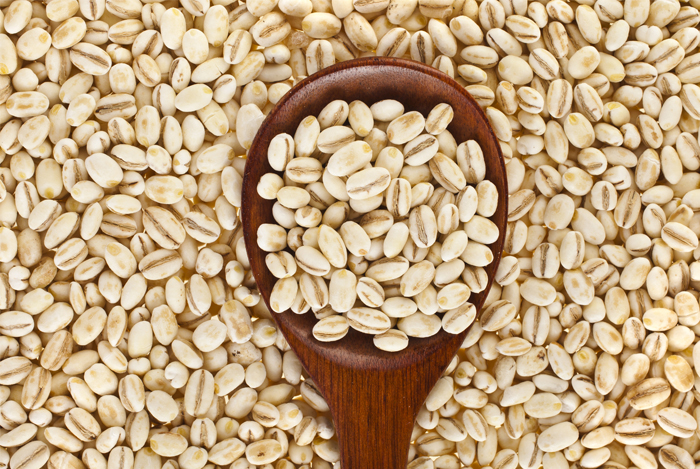
Barley and oats are very similar in terms of their nutritional benefits because they share the special type of fiber that oats are so well-known for: beta-glucan fibers.
These fibers help satiate you longer which reduces appetite and improves blood sugar levels, especially after a meal. These specific nutrients also help keep you regular and eliminate unhealthy levels of cholesterol from the body.
Barley is also thought to be a very energizing grain. Unless you have a sensitivity to gluten or celiac disease where you must avoid gluten at all costs, barley is a grain you should attempt to include in your diet. It’s low in calories but packed with nutrition!
Barley is a great source of B vitamins, protein, fiber, magnesium, manganese, zinc, iron, and folate. It’s also high in protein and a great source of several key factors that make it one of the best whole grains for weight loss.
In several studies, whole grain barley was shown to reduce hunger during and after meals as well as improve overall satiety and reduce high blood sugar levels. Barley, along with rye (see below), also offered greater benefits for metabolic function after a meal than other types of whole grains.
Tips for choosing barley at the store:
There’s one caveat to barley that you should know about when it comes to helping you lose weight. Pearl barley, or flaked barley, is not associated with the same benefits that hulled barley is.
Hulled barley is the whole grain form meaning it contains all of the three parts of a whole grain. While it has been hulled to remove the outer, indigestible shell of the grain, its overall nutrients still remain intact.
Pearl barley and flaked barley have had the bran and outer husks removed which reduces many of the top benefits that barley provides for a healthy diet.
So when you purchase barley at the store, always go for the hulled variety when possible. It takes a little longer to cook than pearled barley but will ofer you many more health benefits since it’s the whole grain form of barley.
Tips for preparing barley:
One way to get the benefits of barley is to try using it with steel-cut oatmeal first to test out how you like it. The two grains take similar amounts of time to cook and this is a great way to enjoy the flavors that barley has to offer without overwhelming the palate.
Barley is less sweet than oatmeal and a little bit more of a grainy tasting than oats, so mixing them together can help you adapt to the taste a bit easier.
Barley is also a great addition to any dinner meal. It can be prepared savory style and is commonly used in soups and stews of many kinds.
4. Quinoa
Quinoa is not actually a grain but is actually a seed. Because it cooks just like grains do, it’s commonly referred to as a pseudo-grain or ancient grain.
Other pseudo-grains include chia, amaranth, buckwheat, teff, millet, and kañiwa. These seed like grains are packed with protein, iron, magnesium, and are complete sources of protein.
Quinoa is especially good for weight loss because it is filling and satisfying just like oatmeal and other grains are. The protein found in quinoa is also a great way to improve metabolism and retain lean muscle.
Whole grain quinoa can be bought in flake, seed, or flour form but for the most benefits, it’s best to choose whole grain quinoa flakes or the whole quinoa seed. It comes in white, red, and black varieties and each variety is similar in the nutritional benefits that they provide.
Tips for choosing quinoa at the store:
Look for plain, whole quinoa or whole grain quinoa flakes without additives such as sugar. It’s also a good idea to avoid breakfast bars and granola bars made with quinoa since they don’t offer the same benefits that the whole grain includes.
Quinoa can be bought in the bulk section to help save you money. It’s a pricier grain than oats but is very affordable when bought in bulk form!
Tips for preparing quinoa:
Quinoa can be prepared just like any other grain, either sweet or savory style. The whole grain flakes make a great alternative to oatmeal while the seed form of quinoa is a great replacement to rice in a savory dish. Try using different herbs and spices to see how you enjoy quinoa best!
5. Wild Rice
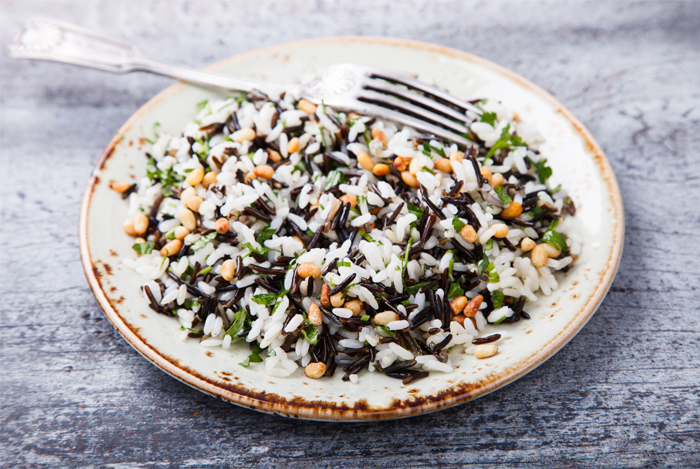
Wild rice is an aquatic grass that’s incredibly high in protein and key minerals necessary for losing weight such as magnesium, iron, and manganese. Even though it’s not an actual grain it cooks just like regular rice and is marketed as a whole grain food.
Wild rice is a good source of fiber and has double the protein and fiber of brown rice. It’s also high in anthocyanins, the type of antioxidants that blueberries and blackberries are so well-known for.
Wild rice is a much more nutritious choice than white rice and even better for you than brown rice because it packs more nutrition into each serving while also improving blood sugar levels better than regular varieties of rice.
Even though it’s more beneficial for your health, wild rice can still be prepared just like regular rice and is great for improving blood sugar levels and keeping you satisfied after a meal. It’s also incredibly easy to digest and free of gluten.
If you’re wondering about calories, you’ll also be happy to know that the calorie content in wild rice is comparable to other grains such as oats, yet it’s lower in fat and richer in antioxidants. All of these reasons make wild rice one of the best whole grains to eat for weight loss.
Tips for buying wild rice at the store:
Look for wild rice that is dark black in color and not mixed with other grains. Many marketing companies will try to sell wild rice blends or other types of rice with wild rice, but you won’t get the same benefits from these processed blends.
Look for whole grain wild rice. It should be black in color and is typically grown in Canada or Minnesota which many brands will list on the package.
Tips for cooking wild rice:
When preparing wild rice, cook it just like you would other types of rice and flavor it with herbs and spices to your liking. It can be served at breakfast, lunch, or dinner either sweet or savory style.
Wild rice is delicious when prepared with some coconut aminos (a low-sodium alternative to soy sauce), lemon, black pepper, and mixed veggies. You can also toss in some leafy greens and your favorite source of protein.
Quick cook varieties of wild rice are also available at the store. These cook up quicker than regular wild rice since they have been pre-boiled before packaging. Quick wild rice will cook up in just 5 minutes versus 25 minutes which is how long regular wild rice cooks. Choose the best option that works for you. Both are great!
So there you have it!
These five grains are some of the best whole grains to eat for ultimate weight loss compared to grains lower in fiber and nutrition. Other key grains that are beneficial for your health are whole grain rye and any of the other pseudo-grains listed above such as chia, buckwheat, and millet.
Always keep in mind that serving sizes are important, even when it comes to these whole grains that can help you lose weight. Overeating any food, healthy or not, is not the best way to go about weight loss. So read the package and be mindful of your serving sizes depending on the grain you’re preparing.
For more tips on losing weight, check out these 10 food combinations that will boost your metabolism quickly!
The post The Best Whole Grains for Ultimate Weight Loss appeared first on Nutrition Secrets.
http://www.nutritionsecrets.com/the-best-whole-grains-for-ultimate-weight-loss/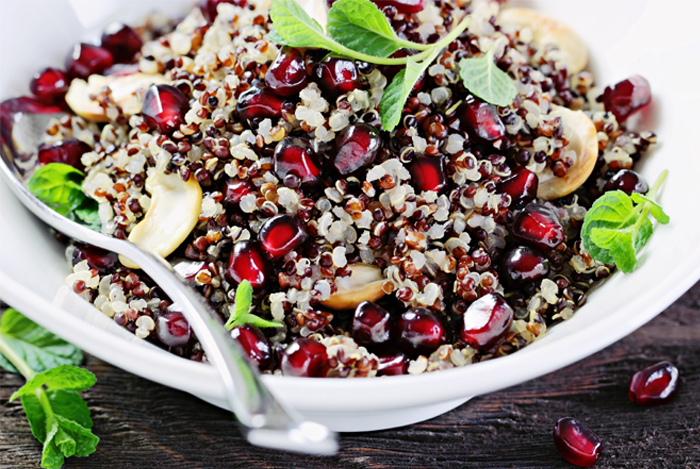
No comments:
Post a Comment